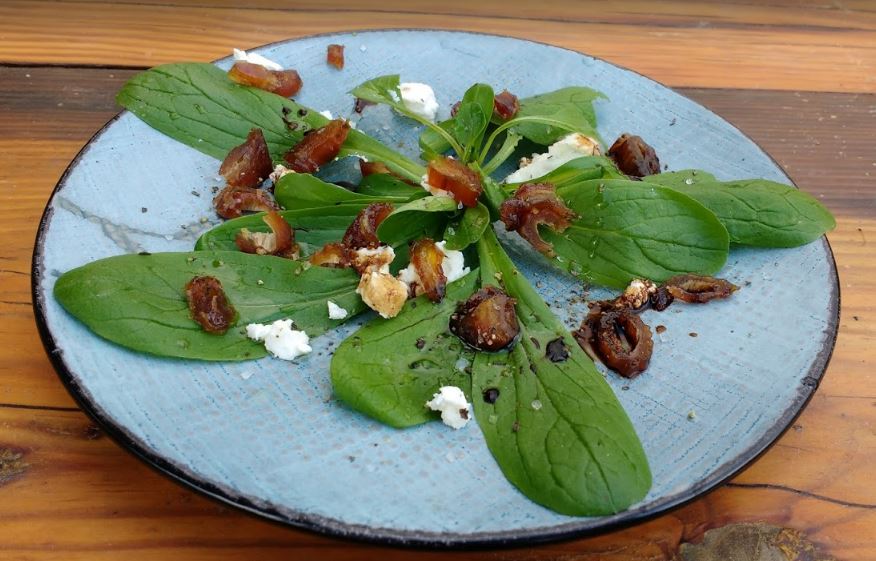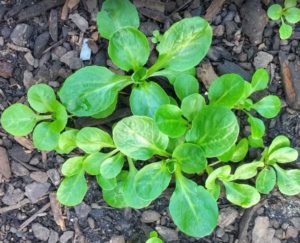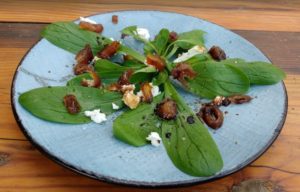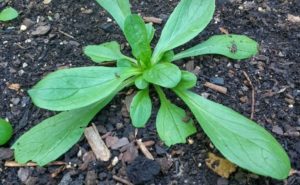This article on growing mâche is part of our Green of the Month series. To read the rest of the articles in the series, click here.
I used to spend a lot of time in France. One of the things that I loved most about my trips was grocery shopping. Every visit to the market was an education in an astounding assortment of fresh greens that simply didn’t seem to exist in the U.S.
One year, in late February, I discovered a green called “mâche.” Based on my remedial French, I thought that word meant “to chew.” With a name like that and the fact that the plant looked a bit like a weed, I didn’t have a lot of confidence that it would be good.
Still, I am all about having food adventures. I bought a big bag and made up my mind to figure out what this stuff was and how to use it. I took it back to our vacation apartment, rinsed a bunch, and hesitantly nibbled the end of a leaf.
It was love at first bite! The nutty, tangy, almost meaty qualities of that incredible green had me hooked.
The Goods on Mâche
There is so much to love about mâche (Valerianella locusta), which is also called lambs lettuce or corn salad. I’ve already touched on the taste, which is so unique and satisfying that I consider it an absolute must in my winter diet. But there are other important reasons I love mâche as a gardener.
1. Mâche Is Extremely Cold-Hardy
Mâche is one of the most cold-hardy greens you can grow. It can tolerate temperatures down to as low as 5° F or -15° C without row protection.
In some areas, such as USDA planting zones 6b-7a, mâche can even be started indoors and transplanted in late October for a late winter to early spring harvest. In cooler climates, it can be one of your earliest planted greens.
2. Mâche Is Nutritious
Want to get 142% of your vitamin A; 64% of your vitamin A; 18% of your manganese; and roughly 12% of your iron, B6, and potassium in only 21 tasty calories1)https://nutritiondata.self.com/facts/vegetables-and-vegetable-products/2426/2? Do you also want to load up on beneficial and delicious phytonutrients?
Well then . . . have yourself a 100-gram serving of mâche and check that off your to-do list!
3. Mâche Is a Gourmet Green
Mâche has actually been in cultivation for hundreds of years and was well-known foraged fare long before that. Until recently, it was mostly considered a “peasant” food (as in, reserved for people who actually ate well from working the land).
Lately, though, it’s become a gourmet delicacy. Given its short shelf-life, you don’t find mâche on supermarket shelves in the U.S. much. So, it usually only turns up in personal gardens and high-end farmers’ markets. However, among gourmands, it’s a well-known and sought-after delicacy.
I don’t know about you, but as a person from the country who grows my own food, I am totally content to eat like a peasant every day. However, it’s kind of satisfying to know that I can eat this all winter long, for the price of a packet of seeds, while others go to great lengths (and costs) to source this specialty green!
Recipe: Mâche Rosette Salad
Mâche is great served with a simple vinaigrette. However, it really shines when paired with flavorful cheeses like blue, feta, or chevre. I love to use it as an appetizer or canape. Here’s my favorite way to serve it:
- 1 whole mâche rosette (washed, roots removed)
- 1 tsp. flavorful cheese bits (blue cheese, feta, or chevre)
- 1 tsp. dried fruit (cranberries, currents, date pieces, etc.)
- Drizzle of mushroom-infused oil (e.g., truffle oil, morel oil, or shiitake oil)
- 1/2 tsp. Balsmic or red wine vinegar
- Cracked sea salt and pepper (to taste)
Put the mâche rosette on a small appetizer or cheese plate. Crumble the cheese and fruit on top. Drizzle with oil and vinegar. Sprinkle with the large-grained sea salt and pepper. Serve and enjoy.
If you are having a party, you can make a platter full of these. Or, you can use them as an appetizer course for a multi-course plated meal. They are super simple to make, but have a huge impact in terms of flavor and prettiness.
A Few Cautions About Mâche
There’s a lot to love about mâche. However, there are a couple of complications, as well.
1. Cold Weather Is Required
Mâche is a cold-weather crop. It bitters and bolts at the first hint of heat. Where I live in North Carolina, it is impossible to grow in spring because our weather oscillates between warm and cold starting in February.
For fall planting, I have to wait to start the seeds until mid-October. Even then, with our ups and downs in temperatures, germination is irregular. Seeds can take over a month to germinate and quite a few fail to sprout.
Also, growth stops when days get into the 70’s. That, paired with the fact that days are shorter at this time of year, means slow growing. It takes about 70-90 days to get rosettes where I live.
2. Eat Immediately
Mâche is not a very durable green. It won’t last nearly as long as heads of lettuce or spinach in your fridge. So, if you happen to find some to buy, use it right away. And if you grow it at home, harvest when you plan to use it for best results.
Growing Mâche
As long as you meet the cold-weather requirement, growing mâche is fairly simple. This plant is often called corn salad because it turned up over winter in fields that had previously been used for heavy feeding crops like corn or wheat.
In my crop rotation, I use this plant in the same way I would turnips. As long as you are willing to wait a couple months for your harvest, mâche is a great nitrogen scavenger. I will often plant it in a bed I previously used for heavy and medium feeders and let it glean the last of my nitrogen from the soil over fall and the start of winter.
Read More: “Supercharge Your Garden! 4 Steps to Vibrant Soil Using Compost and Crop Rotation”
Soil Preparation
Mâche can grow in many soil types. However, it does best in soil that has some organic matter and a fair amount of nutrients. Planting it in fall, in beds that were previously prepared for other vegetables, is perfect.
Seed Starting
You can start mâche indoors in flats or sow it directly in the garden. Either way, the environment should be cool and have plenty of light. If you are starting seeds indoors, under lights, make sure your lights aren’t over-warming the soil. Temperatures around 50°F or 10°C seem to work best for good germination.
When starting seeds outdoors, because temperatures can be irregular, overseed to ensure that you get a good crop. If your planting conditions oscillate between hot and cold, consider starting seeds in partial shade to encourage faster sprouting. Once you have a few true leaves, plants prefer full sun.
Germination can be irregular, with your first seedlings appearing as soon as 7 days after planting and others taking up to a month. Keep the first two inches of soil moist until plants are established.
Young Plant Care
Since germination is irregular and takes weeks to a month, I plant mâche in blocks rather than rows. I thin any extra plants to allow about 4-5 inches or 10-13 centimeters in diameter for mature size.
Cool soil tends to retain more moisture than warm soil. Unless you live in a particularly dry area, watering once a week is usually sufficient for growing mâche.
There also tends to be less weed pressure in cool weather. Yet early germinating weeds like henbit and chickweed will out-compete mâche as winter gives way to spring. So, if you are growing mâche for an early spring crop, watch for and remove early season weeds as they emerge.
Harvesting
My favorite way to harvest mâche is to cut the plant from the crown, leaving the roots in the ground to decompose. Some people do harvest the large outer leaves periodically. However, this plant is very slow to mature and produces a limited number of leaves. So, in my opinion, it’s not a great choice as a come-and-cut green.
Varieties of Mâche
Mâche comes in small- and large-seeded varieties. Large-seeded mâche grows faster and larger than small-seeded. Most of the improved or market garden mâche seeds are large-seeded.
Small-seeded mâche is more flavorful and more cold-hardy. Small-seeded mâche can be winter grown, in a cold-frame or greenhouse, down to USDA planting zone 5. It tends to stay very small—only 2-3 inches or 5-8 centimeters across in diameter—and will become stringy and bolt with just a day or two of heat.
In seed catalogs, mâche is also often referred to as corn salad or corn mâche. So, when you are looking for seed vendors, use both search terms for best results.
Unconventional Growing Tips for Adventure Gardeners
Since mâche is a compact green and only germinates in cold weather, I scatter all my extra seeds in my edible landscape areas, such as under my fruit trees and bushes or in between my strawberries. I cover with a little compost and let them be.
Eventually some of those seeds germinate and I get a bonus crop of mâche with almost no work. For the plants that come up a bit later in spring, they won’t be as tasty, so I leave them to seed out for future harvests.
Despite the fact that mâche started as a weed in field crops, so far it hasn’t been invasive in my yard. That’s probably because I love it so much and eat most of the plants before they can go to seed!
What Do You Think?
Have you grown or tried mâche lettuce? What do you think of it? How do you prepare it? Do you have any growing tips to share with the TGN Community?
__________________
This article was originally published on January 18, 2019.

Tasha Greer is a regular contributor to The Grow Network and has cowritten several e-books with Marjory Wildcraft. The author of “Grow Your Own Spices” (December 2020), she also blogs for MorningChores.com and Mother Earth News. For more tips on homesteading and herb and spice gardening, follow Tasha at Simplestead.com.
References
| ↑1 | https://nutritiondata.self.com/facts/vegetables-and-vegetable-products/2426/2 |
|---|











COMMENTS(10)
In my zone 7a East Tennessee garden I have great luck with volunteer seedlings from seed I scattered in previous years. I nearly always have nice sized plants by mid January. I have grown mache for many years since reading about it in Eliot Coleman’s the Four Season Harvest.
Hey Fts – I love that Eliot Coleman book. He’s the man on the never-ending greens gardening! Sounds like we have similar growing conditions. I’m also zone 7a, Northwestern North Carolina garden. I am going to buy some large bags of seeds this year and see if I can’t get the volunteer mache machine going strong! I had a huge crop this year and was so happy to be eating it all winter long (even had some last night)! Thanks for reading!
Challenge accepted. To-do list activated. 🙂
Mache has always sounded so exquisitely tasty that I have tried growing it several times. I am curious about why the germination is so erratic. I thought it was just that I missed it or the birds or bunnies got it. Or our tendency to have some mild nights in latter May and a hard frost in early June. The other thought was that it was an issue of viability of the seed. How long do you generally keep these? Hope is re-kindled. I will pull out the seeds i got a couple of years ago and be more patient about emergence. And regarding a permanent, self-seeding patch: Would you plant only mache in it, or try for a sort of self-nourishing salad guild? Would you refresh the soil by mulching in the Fall or stirring in a little compost in the early Spring? And when I triumphantly assemble my plates of tidbits, would this be considered finger food, ex. tearing off a stem and rolling up the tasty bits in it, or pinching up a morsel nibbling bits as the rest of the meal gets eaten (My husband is not a nibble-type of person. He will get a bowlful with a spoon). Last question: would I be able to extend my mache season by inter-planting it with a crop that would give it increasing shade as spring progresses? Many thanks as ever, Sandy Forest
Hey Sandy – Great questions. I think the germination rates are more because this plant still acts like a weed. So, it tends to germinate better if allowed some time to stratify in the soil before germination and is given free will over when and where to germinate. There are some more cultivated types that you can find at Johnny’s seeds. They have slightly better germination rates, but haven’t proved as cold-hardy in my garden. It’s hard to tell how long these seeds are viable since they have irregular germination. But my guess would be 3 years, if stored in a cool, dry, dark location. Mache does work great for intercropping. I’ve grown them under decidious perennial plants and they continue to grow even as the leaves come in. I would guess that they can tolerate about 40-50% shade cover and still grow at a reasonable rate. My salad foraging patches have lots of mixed things like chickweed, chicory, cresses, mustard, purslane, dandelion. As long as you are grazing the greens of the more aggressive plants regularly, slower growing mache could fit right in. The leaves aren’t quite big enough to fold around tidbits. But, they are so adorable, I hate to chop them up in a salad which is why I like to serve the whole plant drizzled in goodies. I hope you have good luck growing mache this year!
It looks like mâche is sometimes also known as “vit”. I don’t know if that just refers to a particular variety though. I am in zone 4a, and this winter one of my neighbors tried an experiment of growing salad greens under low hoops covered with sheets of clear plastic. After sub-zero temperatures in January, I was surprised to see his plants still alive and healthy under the snow. Now I think I want to try that next winter, and mâche will definitely be one to grow. I really miss greens in the winter, and they are expensive to buy.
Oops, I forgot to reply on the compost or mulch question – light mulch in fall or compost in spring is fine. They don’t need much once established though, so maybe an inch or so a year.
Hey Deborah – If you haven’t read Four Season Harvest by Elliot Coleman, you may want to check it out. He’s the master of growing greens year round. Also Niki Jabbour’s year round vegetable garden is another great read. She’s in Nova Scotia and gardening in cold frames year round. There are several seed sellers out there who refer to mache as vit, so I think it’s an alternative common name. Good luck growing lots of winter greens in the future!
Marjorie,don’t overlook chickweed! It is a wonderfully useful little early spring green. So good eaten raw and also medicinal. I put it in my boo-boo salve to help heal skin conditions. Best eaten early, as it gets thicker stems that aren’t as tender later in the season.
Janet – You are so right about chickweed! I haven’t written a growing guide on it since it pretty much grows itself. But TGN has this wonderful article on wild chickweed for those who are interested: https://thegrownetwork.com/wild-chickweed/. When it gets a little stouter, I just cook up my chickweed and pureee it. It still tastes great even later in season if you’re willing to put it in the food processor! Thanks for your suggestion! Tasha